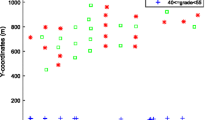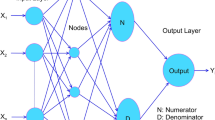Abstract
This article presents new neural network (NN) architecture to improve its ability for grade estimation. The main aim of this study is to use a specific NN which has a simpler architecture and consequently achieve a better solution. Most of the commonly used NNs have a fully established connection among their nodes, which necessitates a multivariable objective function to be optimized. Therefore, the more the number of variables in the objective function, the more the complexity of the NN. This leads the NN to trap in local minima. In this study, a new NN, in which the connections based on the final performance are eliminated, is used. Toward this aim, several network architectures were tested, and finally a network which yielded the minimum error was selected. This selected network has low complexity and connection among nodes which help the learning algorithm to converge rapidly and more accurately. Furthermore, this network has this ability to deal with the small number of data sets. For testing and evaluating this new method, a case study of an iron deposit was performed. Also, to compare the obtained results, some common techniques for grade estimation, e.g., geostatistics and multilayer perceptron (MLP) were used. According to the obtained results, this new NN architecture shows a better performance for grade estimation.





Similar content being viewed by others
References
Arpat, B., 2005, Sequential simulation with patterns, PhD thesis, Stanford University.
Ballard, D., 1987, Modular learning in neural networks, in Sixth National Conference on A.I., v. 1, p. 13–17.
Guardiano, F., and Srivastava, R. M., 1993, Multivariate geostatistics: beyond bivariate moments: geostatistics-Troia, in Soares, A., ed., Geostatistics-Troia, v. 1: Kluwer, Dordrecht, p. 133–144.
Jacobs, R., and Jordan, M., 1993, Learning piecewise control strategies in a modular neural network: IEEE Trans. Syst. Man Cybern., v. 23, no. 2, p. 337–345.
Jacobs, R., Jordan, M., and Barto, A., 1991, Task decomposition competition in a modular connectionist architecture: the what and where vision tasks: Cogn. Sci., v. 15, p. 219–250.
Ke, J., 2002, Neural network modeling of placer ore grade spatial variability. Unpublished doctoral dissertation, University of Alaska Fairbanks, 251 p.
Koike, K., Matsuda, S., and Gu, B., 2001, Evaluation of interpolation accuracy of neural kriging with application to temperature-distribution analysis: Math. Geosci., v. 33, no. 4, p. 421–448.
Lacassie, J. P., Solar, J. Rd., Roser, B., and Hervé, F., 2006, Visualization of volcanic rock geochemical data and classification with artificial neural networks: Math. Geosci., v. 38, no. 6, p. 697–710.
Mahmoudabadi, H., Izadi, M., and Menhaj, M. B., 2009, A hybrid method for grade estimation using genetic algorithm and neural networks: Comput. Geosci., v. 13, p. 91–101.
Mariethoz, G., Renard, P., and Straubhaar, J., 2010, The direct sampling method to perform multiple-point simulations: Water Resour. Res., v. 46, no. W11536. doi:10.1029/2008WR007621.
Matías, J. M., Vaamonde, A., Taboada, J., and González-Manteiga, W., 2004, Comparison of kriging and neural networks with application to the exploitation of a slate mine: Math. Geosci., v. 36, no. 4, p. 463–486.
Porwal, A., Carranza, E. J. M., and Hale, M., 2004, A hybrid neuro-fuzzy model for mineral potential mapping: Math. Geosci., v. 36, no. 7, p. 803–826.
Samanta, B., Bandopadhyay, S., and Ganguli, R., 2004, Data segmentation and genetic algorithms for sparse data division in Nome placer gold grade estimation using neural network and geostatistics: Min. Explor. Geol., v. 11, no. 1–4, p. 69–76.
Singer, D. A., 2006, Typing mineral deposits using their associated rocks and grades and tonnages in a probabilistic neural network: Math. Geosci., v. 38, no. 4, p. 465–475.
Strebelle, S., 2000, Sequential simulation drawing structure from training images, PhD thesis, Stanford University, Stanford, CA, USA.
Tahmasebi, P., and Hezarkhani, A., 2010, Comparison of optimized neural network with fuzzy logic for ore grade estimation: Aust. J. Basic Appl. Sci., v. 4, no. 5, p. 764–772.
Weller, A. F., Corcoran, J., Harris, A. J., and Ware, J. A., 2005, The semi-automated classification of sedimentary organic matter in palynological preparations: Comput. Geosci., v. 31, no. 10, p. 1213–1223.
Weller, A. F., Harris, A. J., Ware, J. A., and Jarvis, P. S., 2006, Determining the saliency of feature measurements obtained from images of sedimentary organic matter for use in its classification: Comput. Geosci., v. 32, no. 9, p. 1357–1367.
Weller, A. F., Harris, A. J., and Ware, J. A., 2007, Two supervised neural networks for classification of sedimentary organic matter images from palynological preparations: Math. Geosci., v. 39, no. 1, p. 657–671.
Yama, B. R., and Lineberry, G. T., 1999, Artificial neural network application for a predictive task in mining: Min. Eng., v. 51, no. 2, p. 59–64.
Zhang, T., Switzer, P., and Journel, A., 2006, Filter-based classification of training image patterns for spatial simulation: Math. Geol., v. 38, no. 1, p. 63–80.
Author information
Authors and Affiliations
Corresponding author
Rights and permissions
About this article
Cite this article
Tahmasebi, P., Hezarkhani, A. Application of a Modular Feedforward Neural Network for Grade Estimation. Nat Resour Res 20, 25–32 (2011). https://doi.org/10.1007/s11053-011-9135-3
Received:
Accepted:
Published:
Issue Date:
DOI: https://doi.org/10.1007/s11053-011-9135-3




